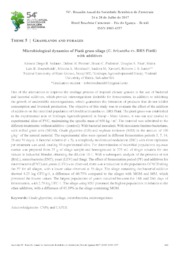Microbiological dynamics of Piatã grass silage (U. brizantha cv. BRS Piatã) with additives.
Microbiological dynamics of Piatã grass silage (U. brizantha cv. BRS Piatã) with additives.
Author(s): SEDANO, A. D. B.; PEREIRA, D. H.; PEDREIRA, B. C. e; PINA, D. S.; BOURSCHEIDT, M. L. B.; MOMBACH, M. A.; XAVIER, I. M.; SCHIMTED JUNIOR, R. J.
Summary: One of the alternatives to improve the ensilage process of tropical climate grasses is the use of bacterial and bacterial additives, which provide microorganisms desirable for fermentation, in addition to inhibiting the growth of undesirable microorganisms, which guarantees the formation of products that do not inhibit consumption and livestock production. The objective of this study was to evaluate the effect of the addition of additives on the microbial population of Urochloa brizantha cv. BRS Piatã. The piatã grass was established in the experimental area of Embrapa Agrossilvipastoril in Sinop - Mato Grosso, it was cut and ensiled in experimental silos of PVC, maintaining the specific mass of 650 kg / m3. The material was submitted to the different treatments: without additive - (control); With bacterial inoculant; With inoculante ênzimo-bacteriano, with milled grain corn (MGM); Crude glycerine (GB) and soybean molasses (MSJ) in the amount of 100 g.kg-1 of the natural material. The experimental silos were opened in different fermentation periods 3, 7, 14, 28 and 56 days). A factorial scheme (6 x 5), a completely randomized nodulation (DIC) with three replicates per treatment was used, totaling 90 experimental silos. For determination of microbial populations aqueous extract was prepared from 25 g of silage sample and homogenized in 225 mL of ringer solution for one minute in industrial blender, obtaining the dilution 10-1. With a subsequent analysis of the presence or not (BAL), enterobacteria (ENT), yeast (LEV) and fungi. The effect of fermentation period (PF) and additives for enterobacteria (ENT) and yeasts (LEV) was observed, there was a reduction in the populations Of NCD along the PF for all silages, with a lower value observed at 56 days. The silage containing the bacterial additive showed 4.23 log CFU.g-1, a difference of 60.75% compared to the silages with MGM and MSJ, which presented the lowest values. The largest populations of yeasts occurred between the 14th and 28th days of fermentation, with 2.78 log UFC-1. The silage using MSJ presented the highest populations in relation to the other additives, with a difference of 43.39% in the silage containing MGM.
Publication year: 2017
Types of publication: Abstract in annals or event proceedings
Keywords: Crude glycerine, Ensilage, Enterobacteriaceae, Glycerine, Microorganisms, Silage
Observation
Some of Embrapa's publications are published as ePub files. To read them, use or download one of the following free software options to your computer or mobile device. Android: Google Play Books; IOS: iBooks; Windows and Linux: Calibre.
Access other publications
Access the Agricultural Research Database (BDPA) to consult Embrapa's full library collection and records.
Visit Embrapa Bookstore to purchase books and other publications sold by Embrapa.

